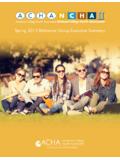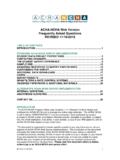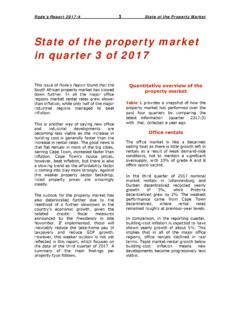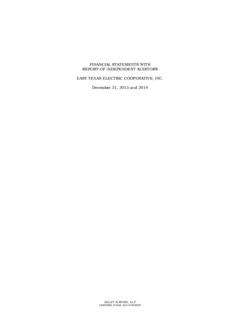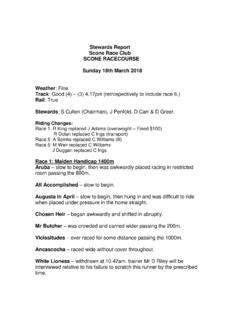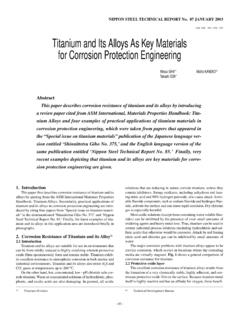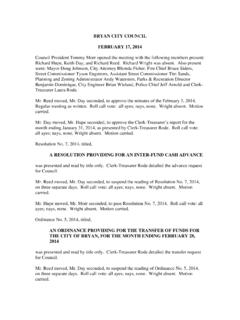Transcription of Spring 2016 Reference Group Executive Summary - …
1 Spring 2016 Reference Group Executive Summary Table of Contents I. Introduction 2. II. Findings A. General Health of College Students 3. B. Disease and Injury Prevention 4. C. Academic Impacts 5. D. Violence, Abusive Relationships and Personal Safety 5. E. Tobacco, Alcohol, and Marijuana Use 6. F. Sexual Behavior 10. G. Nutrition and Exercise 12. H. Mental Health 13. I. Sleep 16. III. Demographics and Student Characteristics 17. IV. Demopraphics of Participating Institutions 18. ACHA, the nation's principal advocate and leadership organization for college and university health, represents a diverse membership that provides and supports the delivery of health care and prevention and wellness services for the nation's 20 million college students. For more information about the association's programs and services, visit , and Suggested citation for this document: American College Health Association.
2 American College Health Association-National College Health Assessment II: Reference Group Executive Summary Spring 2016. Hanover, MD: American College Health Association; 2016. Introduction The ACHA-National College Health Assessment II (ACHA-NCHA II) is a national research survey organized by the American College Health Association (ACHA) to assist college health service providers, health educators, counselors, and administrators in collecting data about their students' habits, behaviors, and perceptions on the most prevalent health topics. ACHA initiated the original ACHA-NCHA in 2000 and the instrument was used nation wide through the Spring 2008 data collection period. The ACHA-NCHA now provides the largest known comprehensive data set on the health of college students, providing the college health and higher education fields with a vast spectrum of information on student health.
3 A revised survey, the ACHA-NCHA-II, has been in use since the fall 2008 data collection period. Please note the ACHA-NCHA II is not appropriate for trend comparison with items from the original ACHA-NCHA survey. Directly comparing pre- and post-redesign estimates on similar data points, without taking into account the impact of the survey's redesign, can lead to an erroneous conclusion. Notes about this report : 1. Missing values have been excluded from analysis and only valid percents are included in this document. 2. Students responding "not applicable" were excluded from several analyses, which are specifically noted throughout this document. This will often explain differences observed between this document and the full data report . 3. A note about the use of sex and gender in this report : Survey responses are reported by sex based on the responses to questions 47a, 47b, and 47c.
4 For the purpose of the ACHA-NCHA report documents, respondents are reported as male or female only when their responses to these three questions are consistent with one another. If students' gender identity is consistent with their sex at birth AND the student selects "no" for transgender, then respondents are designated as either male or female. If respondents select "yes" for transgender OR their sex at birth is not consistent with their gender identity, then they are designated as non-binary. A. respondent that skips any of the three questions is designated as unknown. Totals displayed in this report include non-binary and unknown students. For additional information about the survey's development, design, and methodology, email Mary T Hoban, PhD, MCHES, E. Victor Leino, PhD. or visit This Executive Summary highlights results of the ACHA-NCHA II Spring 2016. survey for Reference Group consisting of 95,761 respondents.
5 The overall response proportion was 2. Findings A. General Health of College Students % of college students surveyed ( % male and % female) described their health as very good or excellent . % of college students surveyed ( % male and % female) described their health as good, very good or excellent . Proportion of college students who reported being diagnosed or treated by a professional for any of the following health problems within the last 12 months: Allergies: % Hepatitis B or C: %. Asthma: % High blood pressure: %. Back pain: % High cholesterol: %. Broken bone/Fracture/Sprain: % HIV infection: %. Bronchitis: % Irritable Bowel Syndrome: %. Chlamydia: % Migraine headache: %. Diabetes: % Mononucleosis: %. Ear infection: % Pelvic Inflammatory Disease: %. Endometriosis: % Repetitive stress injury: %. Genital herpes: % Sinus infection: %. Genital warts/HPV: % Strep throat: %. Gonorrhea: % Tuberculosis: %.
6 Urinary tract infection: %. % of college students ( % male, % female) reported being diagnosed or treated by a professional with one or more of the above conditions within the last 12 months. Proportion of college students who reported any of the following: Attention Deficit and Hyperactivity Disorder (ADHD) %. Chronic illness ( , cancer, diabetes, auto-immune disorders) %. Deafness/Hearing loss %. Learning disability %. Mobility/Dexterity disability %. Partial sightedness/Blindness %. Psychiatric condition %. Speech or language disorder %. Other disability %. 3. Findings continued B. Disease and Injury Prevention College students reported receiving the following vaccinations (shots): % reported receiving vaccination against hepatitis B. % reported receiving vaccination against Human Papillomavirus/HPV (cervical cancer vaccine). % reported receiving vaccination against influenza (flu) in the last 12 months (shot or nasal mist).
7 % reported receiving vaccination against measles, mumps, rubella. % reported receiving vaccination against meningococcal meningitis. % reported receiving vaccination against varicella (chicken pox). Other disease prevention practices reported by college students: % reported having a dental exam and cleaning in the last 12 months. % of males reported performing a testicular self exam in the last 30 days. % of females reported performing a breast self exam in the last 30 days. % of females reported having a routine gynecological exam in the last 12 months. % reported using sunscreen regularly with sun exposure. % reported ever being tested for Human Immunodeficiency Virus (HIV) infection. College students reported the following behaviors within the last 12 months: N/A, did not do this Never* Rarely or Mostly or activity within the sometimes* always*. Percent (%) last 12 months Wear a seatbelt when you rode in a car Wear a helmet when you rode a bicycle Wear a helmet when you rode a motorcycle Wear a helmet when you were inline skating * Students responding "N/A, did not do this activity within the last 12 months" were excluded.
8 4. Findings continued C. Academic Impacts Within the last 12 months, students reported the following factors affecting their individual academic performance, defined as: received a lower grade on an exam, or an important project;. received a lower grade in the course; received an incomplete or dropped the course;. or experienced a significant disruption in thesis, dissertation, research, or practicum work;. (listed alphabetically): Alcohol use: % Gambling: %. Allergies: % Homesickness: %. Anxiety: % Injury: %. Assault (physical): % Internet use/computer games: %. Assault (sexual): % Learning disability: %. Attention Deficit/Hyperactivity Disorder: % Participation in extracurricular Cold/Flu/Sore throat: % activities: %. Concern for a troubled friend Pregnancy (yours or partner's): %. or family member: % Relationship difficulties: %. Chronic health problem or serious illness: % Roommate difficulties: %.
9 Chronic pain: % Sexually transmitted disease/. Death of a friend or family member: % infection (STD/I): %. Depression: % Sinus infection/Ear infection/. Discrimination: % Bronchitis/Strep throat: %. Drug use: % Sleep difficulties: %. Eating disorder/problem: % Stress: %. Finances: % Work: %. Other: %. D. Violence, Abusive Relationships and Personal Safety Within the last 12 months, college students reported experiencing: Percent (%) Male Female Total A physical fight A physical assault (not sexual assault) A verbal threat Sexual touching without their consent Sexual penetration attempt without their consent Sexual penetration without their consent Stalking An emotionally abusive intimate relationship A physically abusive intimate relationship A sexually abusive intimate relationship 5. Findings continued College students reported feeling very safe : Percent (%) Male Female Total On their campus (daytime) On their campus (nighttime) In the community surrounding their school (daytime) In the community surrounding their school (nighttime) E.
10 Tobacco, Alcohol and Marijuana Use Reported use versus perceived use - reported use for all students within the past 30 days compared with how often students perceived the typical student on campus used substances within the same time period. The last line of each table combines all categories of any use in the last 30 days. Cigarette Actual Use Perceived Use Percent (%) Male Female Total Male Female Total Never used Used, but not in the last 30 days Used 1-9 days Used 10-29 days Used all 30 days Any use within the last 30 days E-Cigarette Actual Use Perceived Use Percent (%) Male Female Total Male Female Total Never used Used, but not in the last 30 days Used 1-9 days Used 10-29 days Used all 30 days Any use within the last 30 days Tobacco from a water pipe (hookah) Actual Use Perceived Use Percent (%) Male Female Total Male Female Total Never used Used, but not in the last 30 days Used 1-9 days Used 10-29 days Used all 30 days Any use within the last 30 days 6.


